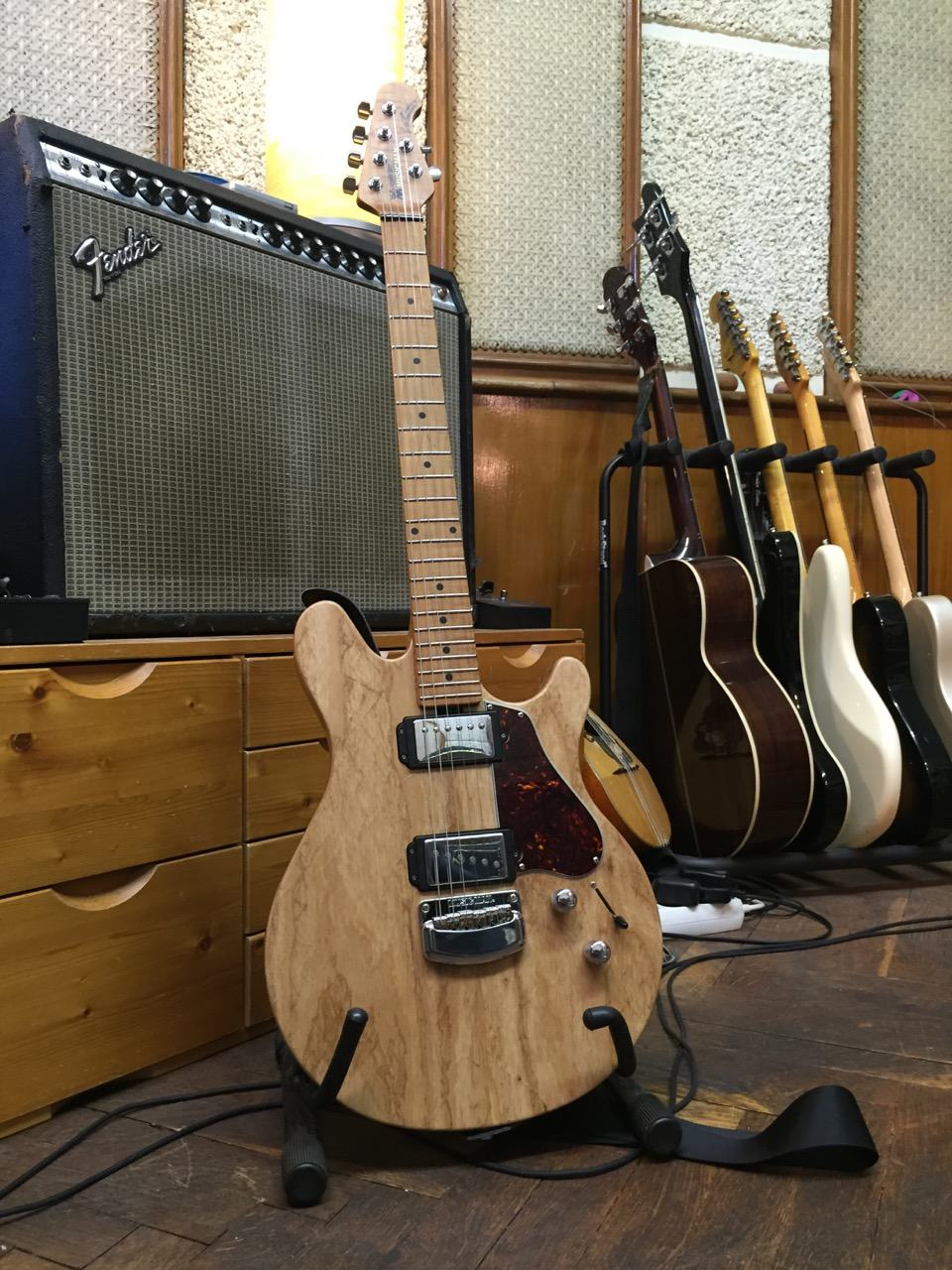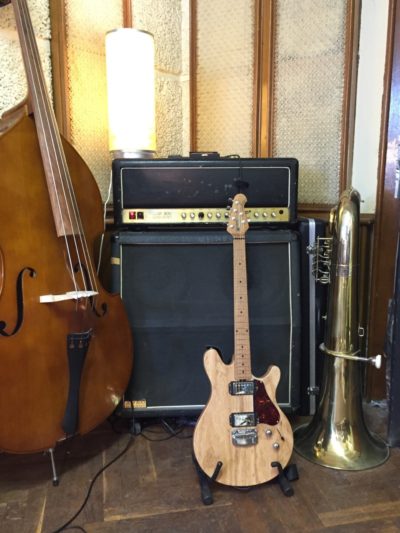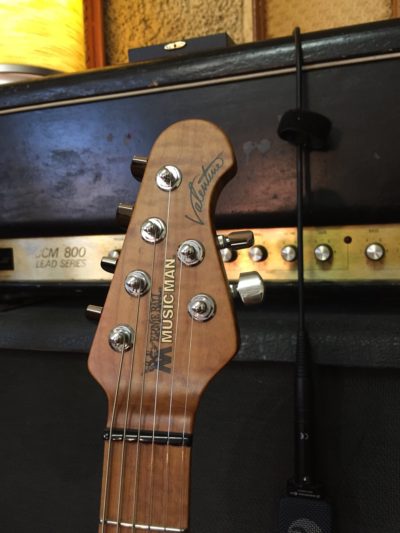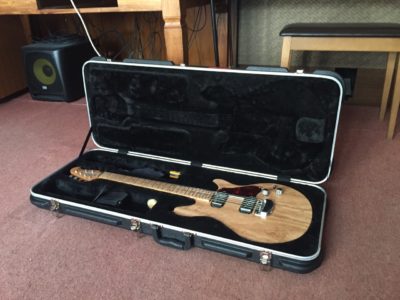When this Valentine guitar arrived, I took a look at it, puffed out a quiet “Hmmph,” and carried on working. Even though I’d seen photos, I was still underwhelmed by the instrument’s appearance: pale, natural wood; a tortoise shell pickguard; and the kind of doughy, conservative shape that could make even an audience of meth-fueled Juggalos fall asleep.
Then I picked it up, and fell in love.

Photo: Charlie Sorrel/Cult of Mac
Why? Because what the Valentine lacks in looks (and to be fair, many people love its classy, conservative design), it makes up for many times over with feel, build quality, sound and overall awesomeness. A friend and I had a little session on it, the recording of which was done on my iPhone, of course.
The Valentine comes from Ernie Ball Music Man, the California company more famous for its guitar strings. It’s a signature model, designed in collaboration with James Valentine of Maroon 5.
Unlike many guitar makers, which put out signature instruments that are little more than rebadged (and repriced) versions of existing models, Music Man gives its artists free reign of its factory — and the help of its engineers. All Music Man guitars are handmade in California.
Valentine designed this instrument so he could use it through his entire set without switching guitars. Loosely, it’s a cross between the Fender Telecaster (the first production electric guitar) and the Gibson ES-335 (the big, hollow guitars played by B.B. King).
Music Man Valentine guitar specs
Here are the Music Man Valentine specs:
The body is made from lightweight swamp ash, cut to evoke the ES-335’s shape. The body is actually cut on a slant, thinner at the top than the bottom, to reduce weight and also make it more comfy to play. The neck is maple, roasted to make it more resonant (and to look cool), and the 22 frets are stainless steel. Stainless steel frets last way longer than the usual nickel, but also tend to destroy tools on installation. It’s nice to find them on a production guitar. The neck’s scale length is 25.5 inches, like a Fender guitar, and the wood is finished not with varnish or lacquer, but by rubbing it with gunstock oil and wax.
The electronics need a battery to power the Music Man’s “silent circuit,” which cuts out hum and interference, and a 20-decibel boost (engaged by pressing the volume knob). There are two pickups: The one at the bridge is a custom-designed cross between a twangy Telecaster single coil and a dirty, growly P-90. The neck pickup is a humbucker, but can be tapped to make a single coil by pressing the tone knob.

Photo: Charlie Sorrel/Cult of Mac
Let’s start with the pickups. They’re amazing. Somehow, they are fat and full-sounding, but without any muddiness. You can hear each string ring out, and chords sound sweetly jangly.
The bridge P-90/Tele pickup sits somewhere between the two sounds that influence it. It can get close to both, but isn’t quite either. I guess if you wanted it to clone both pickups then that would be bad, but in reality it really shines as its own thing. It’s twangy but never harsh, and when you use it in combo with the neck pickup (which itself can be set two ways), it allows an absurd range of tones.
Combine this with the onboard boost (which adds no “color” to the sound — it just makes it louder and more likely to overdrive your amp) and you can dial in tones to suit any song, or any genre of music, from jazz to classic rock to experimental dirt.
The neck pickup is a humbucker, which for our non-guitar nerd readers, is effectively two pickups wired out of phase to cancel any hum that they pick up from radio stations, fluorescent lamps, badly wired appliances and so on. And while it has the thick, heavy sound you expect from a humbucker, it isn’t crazy. If you avoid humbuckers because they are muddy and lack definition, you’ll be surprised. This one is clear and warm. Push the tone knob and the pickup is split to make a single-coil, which is also warm-sounding, but a little sweeter.
Overall, the electronics are very balanced. While you can get some very different sounds from the guitar, the range is more of a continuum than a set of steps. One other note: The volume balance between the pickups is quite even. There’s really no difference (unless you kick in the booster). The string-to-string volume is also very balanced.
How I fell in love with the Valentine guitar

Photo: Charlie Sorrel/Cult of Mac
Above all, then, the Music man Valentine is a joy to use. There’s something about it that keeps you playing. My first day I could’t put it down, and over the past month I’ve used it as my main guitar, playing it for hours every day. Here’s what I’ve found out.
Easily the best part is the neck. Music Man necks have a reputation for being good, but this is far beyond anything else I’ve played. The simple gunstock oil and wax finish is thin enough that it feels like you’re touching bare wood, which is a nice feeling indeed, and makes moving up and down the neck very smooth. The frets are all nicely leveled and polished, and there’s another secret weapon here, found on all new Music Man guitars: the compensated nut.
The nut is the slotted piece of plastic up top that holds the strings in place when they come from the tuning pegs and over the top end of the neck. On a guitar, each string needs to be a slightly different length to allow for the differences in thickness, and to keep them in tune (more or less) all the way up the neck. This is usually done with adjustments at the bridge, but the compensated nut is cut to adjust the strings at the top, too. This makes the biggest difference in playing chords, especially fancy jazzy ones. They sound good all over the guitar. It’s surprising what a difference this makes.
The other thing I love is how easy it is to play the Valentine. A friend of mine (Peter Woods, who you see playing in the video) called it “forgiving.” It’s mellow enough not to punish small mistakes, but the main thing is that every string rings clear, whether played open or fretted high up the neck. On some guitars, the fat strings sound a little dull. Not here. They ring out, and you feel the neck vibrate under them. It feels alive, and is a big reason you’ll keep picking up the guitar to play.
We took the Valentine for a spin at Funkhaus Studios, Berlin’s incredible Communist-era radio station and recording complex. You can see the results in this video. The guitar player is my friend Peter Woods, and the studio belongs to sound engineer Paul Kochenbuch of Halcyon Studio.
https://youtu.be/kO3S0wWG1Pw
First we played through a Fender Twin, and then a Marshall JCM800. Both were recorded with a Sennheiser e 609 mic running into a Mackie Blackjack mixer, and then straight into the iPhone used to record the video.
The audio has been normalized, but nothing else. You can listen for yourself, but the one thing we noticed is that, no matter what amp you plug it into, the guitar still sounds like itself. Even into the Marshall on dirty, it doesn’t get swamped. One other note on amps. At home, I’ve been plugging the Valentine into a Fender Tweed Champ clone, and that might just be the sweetest sound I’ve gotten from it. Even the humbucker, which would usually overpower the little Champ, sounds clear and full.

Photo: Charlie Sorrel/Cult of Mac
Are there any downsides? Not really. The looks might be one, but that’s totally subjective (apart from the tortoise shell pickguard, which is objectively bad). The fact that the Valentine needs a battery is another, although in practice it doesn’t really matter. I ran out the supplied battery in a few days, but I suspect somebody else may have used the guitar before me, because the replacement is still going strong a month later. Just keep a spare in your guitar case and you’ll never have a problem.
The Valentine comes in at $2,099, which doesn’t seem cheap unless you’ve played it. The guitar comes with a custom-fitted case, 11-gauge strings, and some cool stickers. If you’re a beginner, this might be too much — you’re much better off with a cheap guitar and a kick-ass amp. But if you’re in the market for a super-versatile guitar that will never hold you back, which seems to encourage you to play it (and makes everyone who tries it jealous), then you should consider the Valentine. Seriously. I like it so much that I’m considering buying one. I’ve even started to like the way it looks.
Cult of Mac received review units for this roundup. Read Cult of Mac’s reviews policy.
![Music Man Valentine is the only electric guitar you’ll need [Reviews] guitar in case](https://www.cultofmac.com/wp-content/uploads/2016/08/valentine-review-1-1.jpg)

